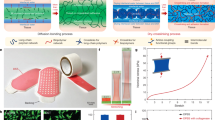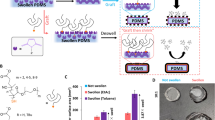Abstract
Protective layers typically act in a passive way by simply separating two sides. Protection is only efficient as long as the layers are intact. If a high level of protection has to be achieved by thin layers, complementary measures need to be in place to ensure safety, even after breakage of the layer—an important issue in medical applications1,2,3,4,5,6,7,8,9. Here, we present a novel approach for integrating a biocide liquid into a protective film (about 300–500 μm thick), which guarantees that a sufficient amount of biocide is rapidly released when the film is punctured. The film is composed of a middle layer, containing the liquid in droplet-like compartments, sandwiched between two elastomeric boundary layers. When the film is punctured, the liquid squirts out of the middle layer. A theoretical model was used to determine the size and density of droplets that are necessary to ensure a sufficient quantity of biocide is expelled from an adequately elastic matrix to provide protection at the site of damage. We demonstrate the utility of this approach for the fabrication of surgical gloves.
This is a preview of subscription content, access via your institution
Access options
Subscribe to this journal
Receive 12 print issues and online access
$259.00 per year
only $21.58 per issue
Buy this article
- Purchase on Springer Link
- Instant access to full article PDF
Prices may be subject to local taxes which are calculated during checkout




Similar content being viewed by others
References
Farrel, B.D., Dessourd, D.E. & Mitter, C. Escalation of plant defenses: do latex and resin canals spur plant diversification Am. Nat. 138, 881–900 (1991).
Gennaro, A.R. (ed.) Remington: The Science and Practice of Pharmacy (Lippincott, Williams & Wilkins, Maryland, USA, 2000).
F1671-97b: Standard test method for resistance of materials used in protective clothing to penetration by blood borne pathogens using Phi-X174 bacteriophage penetration as a test system. Book of Standards vol. 11.03 (American Society for Testing and Materials International, 1997).
Tokars, J.I. et al. Skin and mucous membrane contact with blood during surgical procedures: risk and prevention. Infect. Control Hosp. Epidemiol. 16, 703–711 (1995).
McLeod, G.G. Needlestick injuries at operations for trauma: are surgical gloves an effective barrier? J. Bone Joint Surg. 71, 489–491 (1989).
Data reports from the Exposure Prevention Information Network. (University of Virginia International Health Care Worker Safety Center, 2001) http://www.med.virginia.edu/medcntr/centers/epinet
Case control study of HIV seroconversion in health-care workers after percutaneous exposure to HIV infected blood France, United Kingdom and United States. Centers for Disease Control and Prevention. Mortality and Morbidity Weekly Report 44, 929–933 (1995).
Bell, D.M. Occupational risk of human immunodeficiency virus infection in healthcare workers: an overview. Am. J. Med. 102, 9–15 (1997).
Suzuki, K. et al. Confirmation of HCV transmission through needlestick accident by molecular evolutionary analysis. J. Infect. Dis. 170, 1575–1580 (1994).
Agusti, M. et al. Histological and physiological characterization of rind breakdown of 'Navelate' sweet orange. Ann. Bot. 88, 415–422 (2001).
Riess, G., Cheymol, A., Hoerner, P. & Krikorian, R. Non-aqueous emulsions stabilized by block copolymers: application to liquid disinfectant-filled elastomeric films. Adv. Colloid Interface Sci. published online 2 December 2003 (doi:10.1016/j.cis.2003.10.019).
Krikorian, R. Contribution à l'Étude de la Cristallisation en Solution de Copolymères à Blocs. Application à la Stabilisation d'Émulsions Thesis, Univ. Mulhouse (2001).
Hoerner, P., Riess, G., Rittig, F. & Fleischer, G. Emulsification of poly(ethylene glycol) in thermoplastic elastomers by using polybutadiene-block-poly(ethylene oxide) diblock copolymers as stabilisers. Determination of the liquid phase mobility by pulsed field gradient NMR. Chem. Phys. 199, 343–352 (1998).
Studer, P. Les Copolymers Diblocs Semi-crystallins Thesis, Univ. Haute Alsace, Mulhouse (1998).
Thieme, J., Abend, S. & Lagaly, G. Aggregation in Pickering solution. Colloid Polym. Sci. 277, 257–260 (1999).
Aveyard, R., Binks, B.P. & Clint, J.H. Emulsions stabilized solely by colloidal particles. Adv. Colloid Interface Sci. 100–102, 503–546 (2003).
Gibson, L.J. & Ashby, M.F. Cellular Solids, Structure and Properties 2nd edn (Cambridge Univ. Press, 1997).
Mc Cormack, T.M., Miller, R., Kesler, O. & Gibson, L.J. Failure of sandwich beam with metallic foam cores. Intl J. Solids Struct. 38, 4901–4920 (2001).
Warner, M., Thiel, B.L. & Donald, A.M. The elasticity and failure of fluid filled cellular solids: theory and experiment. Proc. Natl Acad. Sci. USA 97, 1370–1375 (2000).
Van den Sanden, M.C.M., Meijer, H.E.H. & Lemstra, P.J. Polymer Deformation and toughness of polymeric systems: 1. The concept of a critical thickness. Polymer 34, 2148–2154 (1993).
Deegan, R.D., Petersan, P.J., Marder, M. & Swinney, H.L. Oscillating fracture path in rubber. Phys. Rev. Lett. 88, 014304 (2001).
Bricout, F. et al. Virus-inhibiting surgical gloves to reduce the risk of infection by enveloped viruses. J. Med. Virol. 69, 538–545 (2003).
Acknowledgements
We gratefully acknowledge the technical assistance of Raffi Krikorian, Mapa Research Center, Liancourt, France. This work has been partially supported by European Commission (Grant: BMH4-97-2325).
Author information
Authors and Affiliations
Corresponding author
Ethics declarations
Competing interests
Patent filed
Rights and permissions
About this article
Cite this article
Sonntag, P., Hoerner, P., Cheymol, A. et al. Biocide squirting from an elastomeric tri-layer film. Nature Mater 3, 311–315 (2004). https://doi.org/10.1038/nmat1113
Received:
Accepted:
Published:
Issue Date:
DOI: https://doi.org/10.1038/nmat1113
This article is cited by
-
Preparation of core-shell particle of disinfectant agent nanocapsules-skim rubber particles by the heterocoagulation technique
Macromolecular Research (2010)
-
Self-healing materials with microvascular networks
Nature Materials (2007)



